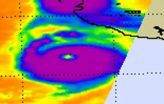(Press-News.org) A new image and video of major Hurricane Dora were released today from NASA's Goddard Space Flight Center in Greenbelt, Md.
Satellites provide a bird's eye view of a hurricane's eye, and NASA noticed Hurricane Dora's eye from several of them. Infrared imagery from NASA's Aqua satellite provided forecasters with a clear view of a cloud-free eye in hurricane Dora as she strengthens near Category 5 status today. Meanwhile the GOES-11 satellite captured a movie of Dora's intensification over the last two days that clearly shows a developing eye.
The Atmospheric Infrared Sounder (AIRS) instrument on NASA's Aqua satellite captured an infrared image of Hurricane Dora's cold cloud temperatures on July 21 at 09:05 UTC (5:05 a.m. EDT). The strongest thunderstorms and convection totally surrounded the very obvious, cloud-free eye.
VIDEO:
This animation of GOES-11 imagery shows the intensification of Hurricane Dora from tropical storm status on July 19 at 14:30 UTC (10:30 a.m. EDT) to major hurricane status on July...
Click here for more information.
The Geostationary Operational Environmental Satellite called GOES-11 provides continuous visible and infrared imagery of the western U.S. and eastern Pacific Ocean basin from its position in space. GOES-11 images were compiled into a movie that runs from July 19 at 14:30 UTC (10:30 a.m. EDT) when Dora was a tropical storm, to July 21 at 14:30 UTC (10:30 a.m. EDT) now that Dora is a major hurricane.
GOES satellites are operated by NOAA, and the NASA GOES Project located at NASA Goddard creates images and compiled them into the video of the storm. The animation includes sped up infrared and visible frames of data that were captured every 15 minutes from the GOES-11 satellite and squeezed down to 26 seconds.
At 11 a.m. EDT on July 21, 2011 Dora's maximum sustained winds were near 155 mph (250 kmh), right on the brink of Category 5 hurricane status. Fortunately, Dora's center is remaining at sea, and will continue to remain at sea as it moves to the northwest near 12 mph (19 kmh). It is expected to continue in that direction for the next couple of days and slow down.
Dora was centered near 17.1N and 106.9W, about 240 miles (390 km) south-southwest of Cabo Corrientes, Mexico. Minimum central pressure is 929 millibars.
Dora is far enough off the coast so that there are no watches and warnings over land. However, Dora is sending large ocean swells against the beaches of western Mexico today. Those large, rough, ocean swells will affect the coast over the next couple of days, and will also begin affecting the southern Baja California coast.
The National Hurricane Center expects some weakening by tonight and a rapid weakening on Friday as Dora starts battling wind shear and moves into cooler waters.
INFORMATION:
NASA's Hurricane page: www.nasa.gov/hurricane; also at Twitter/NASAHurricane and on Facebook as NASA's Hurricane Web Page
NASA satellite video and images show Dora become a major hurricane
2011-07-22
ELSE PRESS RELEASES FROM THIS DATE:
Social media study: Conservatives were top tweeters in 2010 elections
2011-07-22
ANN ARBOR, Mich.---The results of a study on candidates' use of Twitter in the 2010 midterm elections suggest that Republicans and Tea Party members used the social medium more effectively than their Democratic rivals.
The University of Michigan study, among the first to examine the Tea Party's social media strategies, also showed that analyzing Twitter activity can lead to good predictions of election winners.
Various social media tools have become a key part of campaign strategies in recent years. In 2010, nearly a quarter of online adults used social networks including ...
MS research: Myelin influences how brain cells send signals
2011-07-22
COLUMBUS, Ohio – The development of a new cell-culture system that mimics how specific nerve cell fibers in the brain become coated with protective myelin opens up new avenues of research about multiple sclerosis. Initial findings suggest that myelin regulates a key protein involved in sending long-distance signals.
Multiple sclerosis (MS) is an autoimmune disease characterized by damage to the myelin sheath surrounding nerve fibers. The cause remains unknown, and it is a chronic illness affecting the central nervous system that has no cure.
MS has long been considered ...
Smartphone making your eyes tired?
2011-07-22
Rockville, Md. — Several reports indicate that prolonged viewing of mobile devices and other stereo 3D devices leads to visual discomfort, fatigue and even headaches. According to a new Journal of Vision study, the root cause may be the demand on our eyes to focus on the screen and simultaneously adjust to the distance of the content.
Scientifically referred to as vergence-accommodation, this conflict and its effect on viewers of stereo 3D displays are detailed in a recent Journal of Vision article, The Zone of Comfort: Predicting Visual Discomfort with Stereo Displays. ...
UCLA scientists complete first mapping of molecule found in human embryonic stem cells
2011-07-22
Stem cell researchers at UCLA have generated the first genome-wide mapping of a DNA modification called 5-hydroxymethylcytosine (5hmC) in embryonic stem cells, and discovered that it is predominantly found in genes that are turned on, or active.
The finding by researchers with the Eli and Edythe Broad Center of Regenerative Medicine and Stem Cell Research at UCLA may prove to be important in controlling diseases like cancer, where the regulation of certain genes plays a role in disease development.
"Any way you can control genes will be hugely important for human ...
An eye gene colors butterfly wings red
2011-07-22
Red may mean STOP or I LOVE YOU! A red splash on a toxic butterfly's wing screams DON'T EAT ME! In nature, one toxic butterfly species may mimic the wing pattern of another toxic species in the area. By using the same signal, they send a stronger message: DON'T EAT US!
Now several research teams that include Smithsonian scientists in Panama, have discovered that Heliconius butterflies mimic each other's red wing patterns through changes in the same gene.
Not only does this gene lead to the same red wing patterns in neighboring species, it also leads to a large variety ...
U of M researchers may have discovered key to help women fight infections during pregnancy
2011-07-22
MINNEAPOLIS / ST. PAUL (July 21, 2011) – A normal but concerning consequence of pregnancy is the fact that pregnant women are more susceptible to infection. University of Minnesota Medical School researchers have identified the underlying mechanisms for this physiologic immune suppression that may lead to new therapies to help ward off infections during pregnancy.
In pregnancy, immune system suppressing cells (called regulatory T cells) increase in number to protect the baby from attack by the mother's immune system. Because these cells are busy protecting the developing ...
Endangered river turtle's genes reveal ancient influence of Maya Indians
2011-07-22
A genetic study focusing on the Central American river turtle (Dermatemys mawii) recently turned up surprising results for a team of Smithsonian scientists involved in the conservation of this critically endangered species. Small tissue samples collected from 238 wild turtles at 15 different locations across their range in Southern Mexico, Belize and Guatemala revealed a "surprising lack" of genetic structure, the scientists write in a recent paper in the journal Conservation Genetics.
The turtles, which are entirely aquatic, represent populations from three different ...
Massachusetts health-care reform increased access to care, particularly among disadvantaged
2011-07-19
Recent research conducted at Harvard Medical School and the Harvard School of Public Health may have strong implications for informing the controversial debate currently surrounding national health care reform.
In a study published in the July edition of the American Journal of Preventive Medicine, the Harvard research team, led by first author Aakanksha Pande, a doctoral student in the Department of Population Medicine at HMS and Harvard Pilgrim Health Care Institute, found that Massachusetts health reform has effectively increased access to health care and reduced disparities. ...
Children with public health insurance less likely to receive comprehensive primary care
2011-07-19
ANN ARBOR, Mich. — Children with public insurance are 22 percent less likely to receive comprehensive primary care than those with private insurance, according to new research from the University of Michigan Medical School.
Public insurance programs cover one-third of U.S. children, many of whom belong to the most vulnerable groups, including minorities, the underprivileged and those in poor health. This includes children covered by Medicaid and the Children's Health Insurance Program (CHIP).
The study, available online ahead of print in Academic Pediatrics, determined ...
Typhoon Ma-on's eye seen in NASA satellite Images
2011-07-19
The eye of a tropical cyclone is an indication of a strong storm, and Typhoon Ma-on's eye was apparent in visible and infrared imagery captured by NASA's Aqua satellite. Ma-on just achieved Category Four status on the Saffir-Simpson scale that measures hurricane intensity.
The Moderate Resolution Imaging Spectroradiometer (MODIS) instrument that flies aboard NASA's Aqua satellite took an image of Typhoon Ma-on that clearly shows the storm's eye, although it has some high clouds in it. The image was taken at 04:15 UTC (12:15 a.m. EDT) on July 15 as Typhoon Ma-on continues ...



